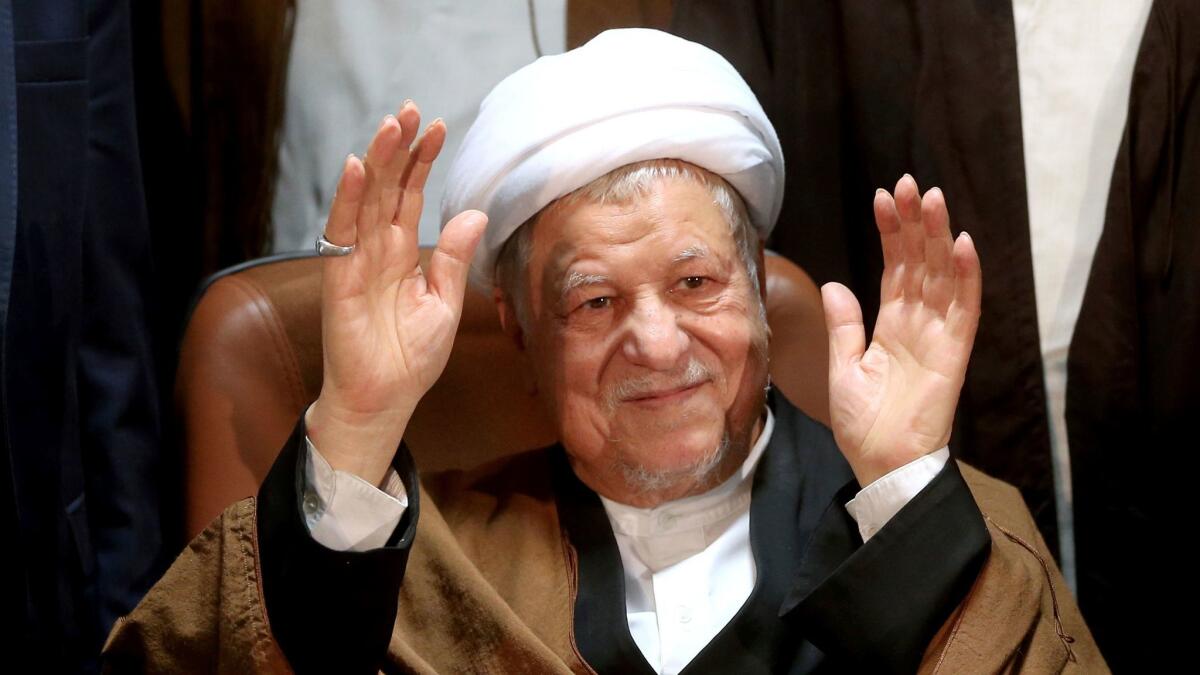Death of former Iranian leader Rafsanjani could be blow to moderates

Reporting from Tehran â The death of former Iranian President Ali Akbar Hashemi Rafsanjani has silenced one of the most powerful allies of moderates in Tehran and is likely to strengthen the hand of conservatives heading into this yearâs presidential election.
Rafsanjani, who supported social freedoms and outreach to the United States, died of a heart attack Sunday at age 82, state media reported. Although his legacy was tarnished by allegations of corruption and authoritarianism, his backing helped moderate President Hassan Rouhani win election in 2013, setting the Islamic Republic on a path to ending its disputed nuclear program and easing its isolation from the West.
For the record:
7:55 a.m. Nov. 27, 2024An earlier version of this article stated that Ali Akbar Hassan Rafsanjani took office as Iranâs president a month after the death of Ayatollah Ruhollah Khomeini. He was sworn in two months after Khomeiniâs death.
âFor those in the West hoping that Iran will move in a more moderate direction, including collaboration with the West on key security issues, [Rafsanjaniâs] death will likely be a big blow,â said Trita Parsi, president of the National Iranian American Council, an advocacy group in Washington.
âDespite his age, and despite his many political losses, he remained a critical player within the Iranian system, often using his influence to move Iran in a more moderate direction while mending fences with the West as well as with Iranâs Arab neighbors.â
Under Rouhani, Iran signed an agreement with world powers to shelve its nuclear program in exchange for the lifting of many Western economic sanctions. The deal has failed to bring significant foreign investment or reduce unemployment, strengthening hard-liners who opposed rapprochement with the West and possibly threatening Rouhaniâs chances at a second term.
Iran declared three days of mourning for Rafsanjani, one of its most significant political figures.
Rafsanjani was an aide to Iranâs revolutionary supreme leader, the late Ayatollah Ruhollah Khomeini, and his pragmatic views on foreign economic investment and cultural issues set him apart from much of the theocracyâs conservative establishment.
Although his influence had waned over the two decades since his presidency, he was a political survivor and behind-the-scenes ally of moderate and reformist forces agitating for looser political and social controls. He called for the release of dissidents and sharply criticized the anti-Western former president, Mahmoud Ahmadinejad, who left office in 2013.
That year, after Iranâs conservative election body barred the aging Rafsanjani from seeking the presidency, he threw his support behind Rouhani, seen as a much friendlier face to the West than Ahmadinejad. After Rouhaniâs election, Rafsanjani was reported to have said, âNow I can die peacefully.â
In Washington, a State Department official close to the Iranian nuclear talks said Rafsanjaniâs support for the deal was crucial. âIf he hadnât supported it ⦠it would not have gone forward,â said the official, who was not authorized to speak publicly.
Born to a pistachio-farming family in southeastern Iran, Rafsanjani studied Shiite Muslim theology at the holy city of Qom along with Khomeini, who led the 1979 revolution that toppled a Western-friendly monarchy.
Khomeini appointed Rafsanjani a commander of Iranâs armed forces toward the end of the devastating Iran-Iraq war that left an estimated 1 million dead from 1980 to 1988.
Khomeini died in 1989, and two months later Rafsanjani took office as president, leading a postwar reconstruction and beginning a period of economic and cultural liberalization. Arts and film began to flourish, men and women could socialize more openly, and women felt more comfortable wearing lipstick or allowing their hair to peek out from under their mandatory headscarves in public.
At the same time, political space remained tightly controlled and Rafsanjani tolerated no challenges to his authority. He stayed publicly silent â and many critics accused him of involvement â when opposition leaders were targeted for assassinations overseas or died mysteriously in police custody. The deaths were never investigated.
He also amassed tremendous personal wealth through a business empire that included pistachios and construction, leading many Iranians to view him as corrupt.
Yet in the context of Iranian politics, he was a relative moderate, attempting outreach to Saudi Arabia and the âGreat Satanâ â the United States.
In the 1980s, as parliament speaker, he served as a go-between for Reagan administration officials during the Iran-Contra affair. As president, in 1995, he offered Oklahoma-based Conoco the first Iranian oil contract with a foreign company since the revolution, but the deal was scuttled by President Bill Clinton.
After his presidency, he served as one of the leaders of weekly prayers at Tehran University, a prominent space to deliver religious and political messages. But he angered the establishment when he backed the Green Movement protesting alleged vote rigging in Ahmadinejadâs 2009 reelection, which prompted a harsh crackdown against opposition politicians and their supporters.
Rafsanjani lost his place among prayer leaders but kept his position as head of the Expediency Council, an advisory body to Supreme Leader Ayatollah Ali Khamenei. With Khamenei in failing health, Rafsanjani was expected to serve as a kingmaker again, playing a key role in determining his successor.
The more immediate challenge is to Iranâs moderates and reformists, a fractious coalition that united behind Rouhani in 2013 and in parliamentary elections last year. Without Rafsanjaniâs support, reformists worry their political gains will erode.
âHis absence may affect the next presidential election and make it difficult for President Rouhani to be reelected,â said Farshad Ghorbanpour, an analyst who sides with the reformists.
âIn any case, it means a shift toward more conservatism within the ruling establishment. Whoever is appointed to replace him in the Expediency Council will for sure be less reformist and less pro-Western.â
Rafsanjani, who is survived by his wife, Effat Marashi, and five children, died at 6 p.m. at a hospital north of Tehran, news agencies reported.
His body was brought to the town of Jamaran, Khomeiniâs former home, where dignitaries arrived to pay their respects. They included Foreign Minister Mohammad Javad Zarif and former President Mohammad Khatami, Rafsanjaniâs successor, who some hope will take over his mantle as figurehead of the moderates.
Special correspondent Mostaghim reported from Tehran and Times staff writer Bengali from Mumbai, India. Staff writer Tracy Wilkinson in Washington contributed to this report.
ALSO:
The fear thatâs keeping Iranian Americans from visiting their homeland
These judges decide the fate of Islamic State fighters and collaborators
UPDATES:
2:50 p.m.: This article has been updated with reaction from a State Department official.
1:25 p.m.: This article has been updated throughout with staff reporting.
10:02 a.m.: This article was updated with additional details about Rafsanjaniâs personal life and political career.
This article was originally published at 8:45 a.m.
More to Read
Start your day right
Sign up for Essential California for the L.A. Times biggest news, features and recommendations in your inbox six days a week.
You may occasionally receive promotional content from the Los Angeles Times.





